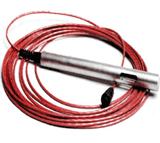Sep 22 2010
PetroSense has developed a DHP digital hydrocarbon probe that provides an ideal solution for detecting and measuring petroleum hydrocarbons present in salt water, in real-time, by utilizing fiber-optic chemical sensor technology. The impact of hydrocarbon contamination is high because of the contaminated marine and salt water environments.
 DHP Hydrocarbon Probe
DHP Hydrocarbon Probe
The PetroSense DHP digital hydrocarbon probe is a 16” tube, measuring 1.5” in diameter, and having a sensor tip and circuit board inside. The probe is connected to a wire to store data. The fiber-optic chemical sensors have been utilized in various applications, such as hydrocarbon leak tracking. The chemical sensors from FCI Environmental create real-time information on contaminants and pollutants in various materials.
The Chief Executive Officer and President of FCI, Peter Gerard said that the demand for monitoring salt water in delicate environments, marinas, and harbors is crucial. A report published by the Natural Resources Defense Council stated that after the 2010 BP oil spill, over 2,200 advisories, health notices, and beach closings were issued in the first three months.